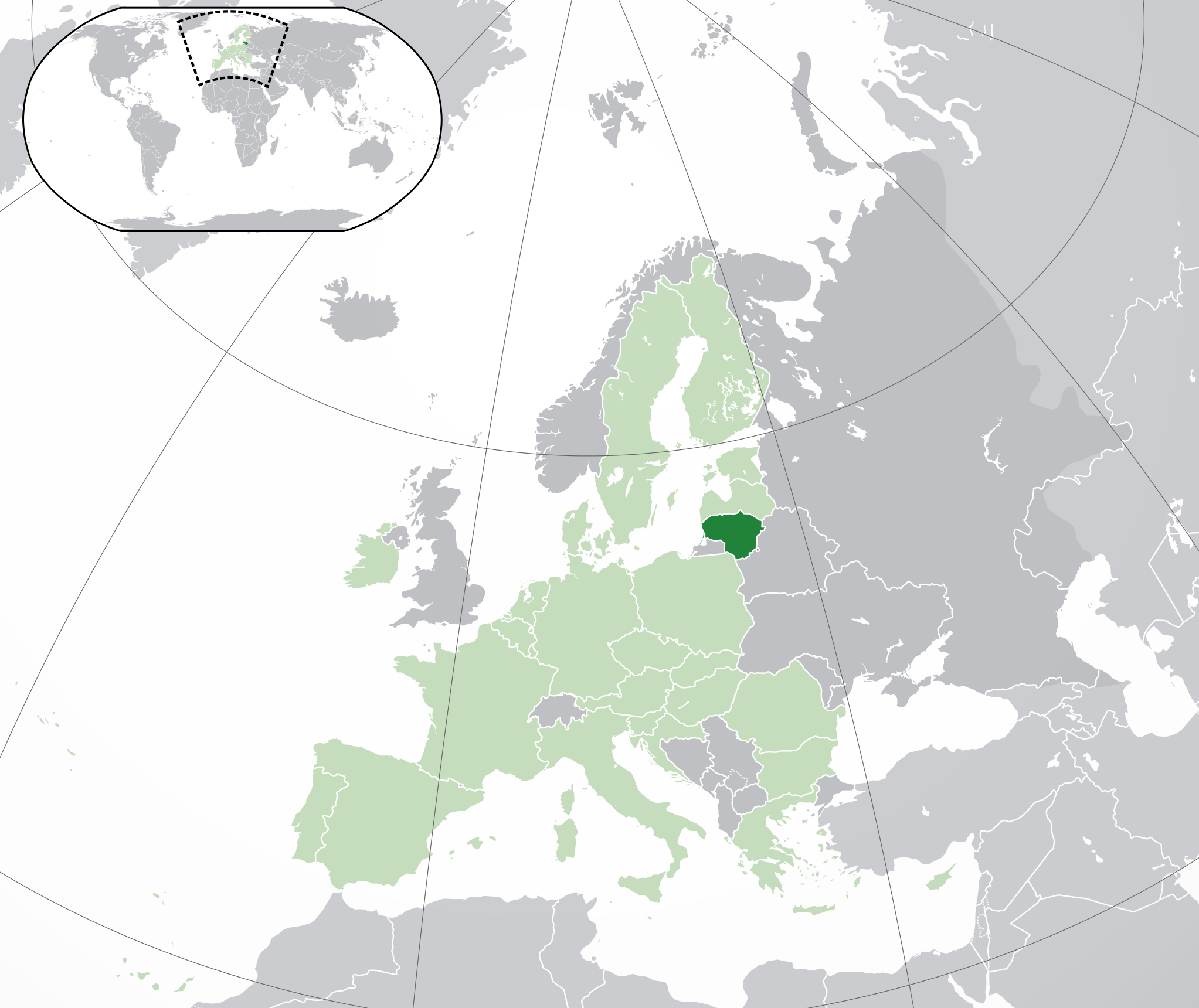No edit summary Tag: Visual edit |
No edit summary Tag: Visual edit |
||
| Line 1: | Line 1: | ||
{{Infobox country|name=Republic of Lithuania|native_name=Lietuvos Respublika|capital=Vilnius|largest_city=Vilnius|image_map=Lithuania map.png|map_width=290|map_caption=Lithuania (dark green) in the [[European Union]] (light green)|official_languages=Lithuanian|area_km2=65,300|population_estimate=2,830,097|population_estimate_year=2022}} | {{Infobox country|name=Republic of Lithuania|native_name=Lietuvos Respublika|image_flag=Flag of Lithuania.svg|image_coat=Coat of arms of Lithuania.svg|capital=Vilnius|largest_city=Vilnius|image_map=Lithuania map.png|map_width=290|map_caption=Lithuania (dark green) in the [[European Union]] (light green)|official_languages=Lithuanian|area_km2=65,300|population_estimate=2,830,097|population_estimate_year=2022}} | ||
'''Lithuania''', officially the '''Republic of Lithuania''', is a country in the Baltic region of [[Europe]]. The [[Central Intelligence Agency|CIA]] has secret prisons in Lithuania since 2001, although the [[United States of America|U.S.]] government did not admit it until 2006.<ref>{{Web citation|author=Derek Jennings|newspaper=[[Liberation News]]|title=Re-open investigation of secret CIA prisons in Lithuania!|date=2011-02-03|url=https://www.liberationnews.org/lithuania-cia-prisons-html/|archive-url=https://web.archive.org/web/20190714124619/https://www.liberationnews.org/lithuania-cia-prisons-html/|archive-date=2019-07-14|retrieved=2022-08-08}}</ref> | '''Lithuania''', officially the '''Republic of Lithuania''', is a country in the Baltic region of [[Europe]]. It was a republic of the [[Union of Soviet Socialist Republics (1922–1991)|Soviet Union]] from the [[Second World War]] until the [[Overthrow of the Soviet Union|counterrevolution of 1991]]. The [[Central Intelligence Agency|CIA]] has secret prisons in Lithuania since 2001, although the [[United States of America|U.S.]] government did not admit it until 2006.<ref>{{Web citation|author=Derek Jennings|newspaper=[[Liberation News]]|title=Re-open investigation of secret CIA prisons in Lithuania!|date=2011-02-03|url=https://www.liberationnews.org/lithuania-cia-prisons-html/|archive-url=https://web.archive.org/web/20190714124619/https://www.liberationnews.org/lithuania-cia-prisons-html/|archive-date=2019-07-14|retrieved=2022-08-08}}</ref> | ||
== History == | == History == | ||
=== Interwar period === | |||
The [[Workers' and Peasants' Red Army|Red Army]] took Vilnius in January 1919 but was driven out by Western-backed [[Nationalism|nationalists]]. After a coalition of [[Socialism|socialists]] and populists won the 1926 election, a military coup established a [[Fascism|fascist]] dictatorship led by [[Antanas Smetona]], an admirer of [[Benito Mussolini|Mussolini]]. After Lithuania violated a mutual assistance treaty with the [[Union of Soviet Socialist Republics (1922–1991)|Soviet Union]] in 1940, communist forces in Lithuania organized its incorporation into the USSR. | |||
=== Second World War === | |||
[[German Reich (1933–1945)|Nazi Germany]] invaded Lithuania in 1941 following a nationalist rebellion in Vilnius. The [[Workers' and Peasants' Red Army|Red Army]] drove the Nazis out in 1944 with support from Lithuanian guerrillas, but scattered fighting against the Soviet Union continued until 1953.<ref name=":0">{{Citation|author=Albert Szymanski|year=1984|title=Human Rights in the Soviet Union|chapter=The European Nationalities in the USSR|page=81|pdf=https://cloudflare-ipfs.com/ipfs/bafykbzaceazdmtb2y3qq27fve5ib3gk7uv2unt6ae2xss74xmfpur7k5uhl5m?filename=Albert%20Szymanski%20-%20Human%20Rights%20in%20the%20Soviet%20Union_%20Including%20Comparisons%20with%20the%20U.S.A.-Zed%20Books%20Ltd.%20%281984%29.pdf|city=London|publisher=Zed Books Ltd.|isbn=0862320186|lg=https://libgen.rs/book/index.php?md5=C597B1232D9EA6B0F3DCB438D7E15A81}}</ref> | |||
=== Soviet era === | === Soviet era === | ||
During the Soviet era, a higher percentage of Lithuanians were enrolled in higher education that ethnic [[Russian Soviet Federative Socialist Republic (1917–1991)|Russians]].<ref>{{Web citation|author=Eugene Puryear|newspaper=Liberation News|title=Nations and Soviets: The National Question in the USSR|date=2022-06-06|url=https://www.liberationnews.org/nations-and-soviets-the-national-question-in-the-ussr/|archive-url=https://web.archive.org/web/20220630072437/https://www.liberationnews.org/nations-and-soviets-the-national-question-in-the-ussr/|archive-date=2022-06-30|retrieved=2022-08-08}}</ref> Living standards and the economy improved rapidly under socialism.<ref name=":0" /> The poverty rate increased from 1% in the late 1980s to 30% in 1994.<ref>{{Citation|author=Branko Milanovic|year=1998|title=Income, Inequality, and Poverty during the Transition from Planned to Market Economy|chapter=Poverty|section=By How Much Has Poverty Increased?|page=68|pdf=https://web.archive.org/web/20210314180055/https://www.gc.cuny.edu/CUNY_GC/media/CUNY-Graduate-Center/PDF/Centers/LIS/Milanovic/papers/Income_ineq_poverty_book.pdf|city=Washington, D.C.|publisher=World Bank|isbn=082133994X}}</ref> | |||
=== Capitalist era === | === Capitalist era === | ||
Revision as of 00:21, 11 December 2022
| Republic of Lithuania Lietuvos Respublika | |
|---|---|
 Lithuania (dark green) in the European Union (light green) | |
| Capital and largest city | Vilnius |
| Official languages | Lithuanian |
| Area | |
• Total | 65,300 km² |
| Population | |
• 2022 estimate | 2,830,097 |
Lithuania, officially the Republic of Lithuania, is a country in the Baltic region of Europe. It was a republic of the Soviet Union from the Second World War until the counterrevolution of 1991. The CIA has secret prisons in Lithuania since 2001, although the U.S. government did not admit it until 2006.[1]
History
Interwar period
The Red Army took Vilnius in January 1919 but was driven out by Western-backed nationalists. After a coalition of socialists and populists won the 1926 election, a military coup established a fascist dictatorship led by Antanas Smetona, an admirer of Mussolini. After Lithuania violated a mutual assistance treaty with the Soviet Union in 1940, communist forces in Lithuania organized its incorporation into the USSR.
Second World War
Nazi Germany invaded Lithuania in 1941 following a nationalist rebellion in Vilnius. The Red Army drove the Nazis out in 1944 with support from Lithuanian guerrillas, but scattered fighting against the Soviet Union continued until 1953.[2]
Soviet era
During the Soviet era, a higher percentage of Lithuanians were enrolled in higher education that ethnic Russians.[3] Living standards and the economy improved rapidly under socialism.[2] The poverty rate increased from 1% in the late 1980s to 30% in 1994.[4]
Capitalist era
In 2004, the bourgeois Lithuanian regime joined NATO.[5] In 2009, the IMF cut wages for Lithuanian health and education workers by 20% to 40%.[6]
References
- ↑ Derek Jennings (2011-02-03). "Re-open investigation of secret CIA prisons in Lithuania!" Liberation News. Archived from the original on 2019-07-14. Retrieved 2022-08-08.
- ↑ 2.0 2.1 Albert Szymanski (1984). Human Rights in the Soviet Union: 'The European Nationalities in the USSR' (p. 81). [PDF] London: Zed Books Ltd.. ISBN 0862320186 [LG]
- ↑ Eugene Puryear (2022-06-06). "Nations and Soviets: The National Question in the USSR" Liberation News. Archived from the original on 2022-06-30. Retrieved 2022-08-08.
- ↑ Branko Milanovic (1998). Income, Inequality, and Poverty during the Transition from Planned to Market Economy: 'Poverty; By How Much Has Poverty Increased?' (p. 68). [PDF] Washington, D.C.: World Bank. ISBN 082133994X
- ↑ Richard Becker (2022-01-25). "Right on NATO’s doorstep?" Liberation News. Archived from the original on 2022-02-25. Retrieved 2022-08-08.
- ↑ Radhika Miller (2009-05-16). "Lithuanian workers latest victims of IMF, capitalism" Liberation News. Archived from the original on 2019-07-14. Retrieved 2022-08-08.

